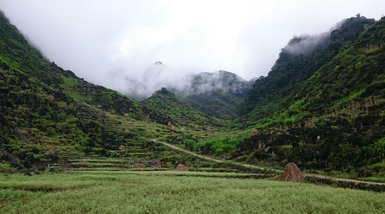Posted by TL Knowledge Team on 27th Mar 2023
How Altitude Affects Terpene Quality and Content of Plants

As one moves up an altitudinal gradient, temperature decreases while precipitation and solar radiation intensity increase. These environmental conditions have a profound influence on the content of terpenes in plants.
For example, at lower altitudes plants are exposed to higher temperatures and less precipitation. This combination of environmental conditions tends to favour the production of sesquiterpenes over monoterpenes. Conversely, at higher altitudes plants are subjected to cooler temperatures and greater precipitation.This environment is more conducive to the production of monoterpenes over sesquiterpenes. All of these environmental factors vary along altitudinal gradients, meaning that the higher up you go in elevation, the more these factors will change. Further, solar radiation affects the rate of photosynthesis, which in turn affects the production of terpenes.
The different terpene profiles produced by plants in response to varying altitudinal conditions can have a significant impact on the taste, smell, and overall quality of the resulting essential oils. Therefore, when selecting essential oils it is important to take into account the specific altitude at which the plants were grown. So, while a plant’s terpene content may be influenced by its environment, the specific conditions within that environment are also important factors.
In general, higher altitudes tend to have lower precipitation levels, higher temperatures, and more intense solar radiation. This combination of factors can lead to higher levels of terpene production in plants.
Plants produce a wide variety of organic compounds that serve many different functions. Terpenes are a class of these organic compounds that are produced by all plants, and they play important roles in plant-animal and plant-plant interactions. Generally, terpenes act as herbivore deterrents, antibacterial and anti-mycotic substances, pollinator attractants and/or signals in plant–plant communication. They can also be involved in plant development and stress responses. The production of terpenes is often increased when plants are under environmental stress, such as high altitudes.
But how does altitude affect these properties? At high altitudes, there is less oxygen available for plants to convert into energy. This means that plants have to adapt in order to survive. It is thought that one way they do this is by producing more terpenes. The thinner air at high altitudes means that plants must work harder to get the same amount of oxygen.Terpenes are known for their ability to withstand low oxygen levels, so by producing more of them, plants are able to better survive in high altitude environments. Not only does altitude affect the amount of terpenes produced by plants, but it also affects the specific types of terpenes that are produced. Different types of terpenes are better suited for different purposes, so by producing different types of terpenes at different altitudes, plants are able to better adapt to their specific environment and maximise their survival chances.
Recently, researchers conducted a study with the of aim “to study whether two very different ecological environments (mountain and plains) would have a significant impact on phytocannabinoids qualitative and quantitative content, flavonoids presence, and terpenoids profile, in order to study the plant phytochemical behavior and its potential to provide nutraceutical substances.” The study was carried out using four strains of the hemp plant.
The study concluded:
“A mountain environment, with condition of UV length exposure and critical conditions, deeply influences the quantity of the inflorescence compounds, favoring the production of CBDA and cannaflavins. Information regarding the differences in industrial hemp inflorescences phytochemical profile supports hemp cultivation in mountain areas as a source of pharmacologically active cannabinoids, terpenes and cannaflavones that are considered also as promising nutraceuticals.”
Precipitation, temperature, and solar radiation all play a role in the terpene content of plants. Precipitation affects the amount of water available to plants, which can impact the amount of terpenes produced. Temperature can affect the rate of photosynthesis and transpiration, which can also impact the terpene content of plants. Solar radiation affects the amount of energy available to plants, which can again impact the amount of terpenes produced. All of these environmental factors vary along altitudinal gradients, meaning that the higher up you go in elevation, the more these factors will change. This change in environment can have a big impact on the terpene content of plants.

